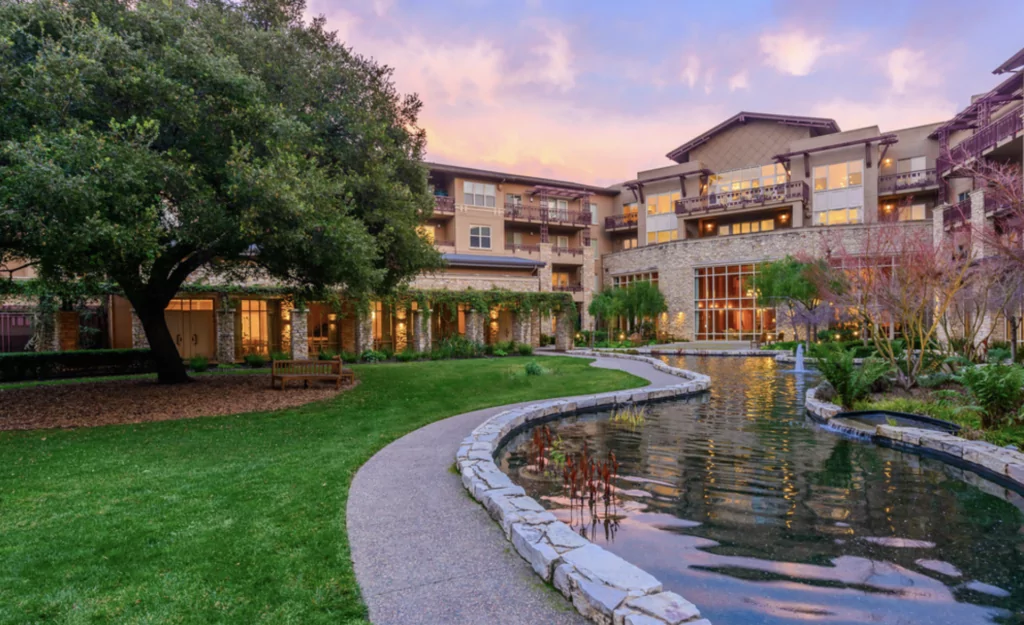With development and new construction still largely on hold throughout the senior living industry, Vi is for now focusing on growth in operations.
Chicago-based Vi has had a largely positive year, with occupancy at its 10 continuing care retirement communities communities (CCRCs) still hovering at the 90% point and, as of September, move-in fees about 30% higher than what leaders expected them to be as the U.S. housing market remains resilient. Staffing and turnover are also heading in the right direction.
The senior living operator also is making headway on its pipeline of community reinvestment and renovations, with plans to spend at least about $70 million annually on projects to keep communities up to date. Recent projects include an independent living expansion at a CCRC in Naples, Florida, that is slated to open next year.
On the technology side, Vi is continuing to push forward with several initiatives, including a recent study conducted with senior-focused virtual reality company Rendever that showed how VR can benefit older adults.
Although challenges remain with regard to expansion, Vi is not in a hurry. The company’s balance sheet and debt profile remains flexible, and it is currently having positive discussions with potential expansion partners.
“We’re pleased where we are as a company and continue to be optimistic about the industry in the longer-term, and know that there are some short term issues,” Vi President Gary Smith told Senior Housing News during a recent interview.
Improvement ahead of growth
Vi has over the years grown primarily through new construction, but with so many challenges with development in the last year, some plans have had to go on hold.
Among them was an effort to return to the senior living rental sector with a project that had been in the works in Arizona. Those plans went on hold last year as interest rates began to climb and disrupted the financial math needed to make development work. Fast-forward to the tail-end of 2023 and those plans are still on hold, Smith said.
For now, Vi is instead focusing on becoming more efficient, especially as many senior living line items remain expensive.
Like many other operators, Vi has sought out efficiency by eliminating its use of agency-sourced workers. In 2021 and into parts of 2022, Smith said Vi saw turnover rates that were higher than typical for the company.
In response, Vi put several initiatives into place to help close the company’s back door, including sign-on bonuses and setting a company-wide $15 per hour minimum wage. The operator also beefed up recruiting in its corporate office and changed its metrics for how applicants are qualified to keep them moving through the hiring process.
“We’ve provided some flexibility to our executive directors,” Smith said. “But are still holding the communities accountable to metrics: How long it’s taking to fill a position, how long it’s taking to bring somebody in for an interview, and how long to make an offer.”
Using that approach, Vi’s turnover rates have settled back to where they were in pre-pandemic times.
Vi is also looking to fine-tune its offerings for the incoming baby boomer generation. Earlier this year, the company publicized its effort to go bigger in memory care, including through the use of new technology.
The tech push has continued with the company’s Rendever pilot. Over a period of about eight weeks at Vi’s community in Naples, groups of assisted living residents spent 45 minutes to an hour using Rendever’s headsets and virtually visiting locations around the world.
A study of those residents showed that more than three-quarters of the residents who participated expanded their social network and attended more events, while 67% saw an improvement to depression.
Those positive results have led the company to roll out the use of VR headsets into its other communities — just one example of how the company is looking to evolve and grow for the future.
“We think it’s not only interesting, but it’s also good from a standpoint of health and wellness,” Smith said.
Vi looks to the future
More generally, Vi has looked to get a better handle on what the incoming baby boomer generation will want from senior housing.
The company in the beginning of the year did some research with a cohort of 2,000 baby boomers aged 68 or older, and with net worths of $500,000 or higher. What the company found through that effort is that, for the boomers, “it really boils down to the experience,” Smith said.
“They have high expectations, but they also are at a point in time where they see age as just a number, and they’re still interested in having a fulfilling life,” he explained. “They want to have social connections, they want to have opportunities for wellness, they want to have interesting dining experiences … they are interested in staying fit, both physically and mentally.”
At the end of the day, Smith believes that the boomers will view luxurious finishes and amenities as a nice-to-have. But it will take a back seat to how they want to live their second chapters.
“What they’re looking for is learning new things, and continuing to expand themselves,” he said.
Although the outlook for development and new construction is fairly dim at the cusp of 2024, that doesn’t mean Vi isn’t thinking about growth. In fact, the company is currently having discussions with potential partners for future expansion.
“I just met with a bank … that was pretty optimistic,” he added. “They’re open for business for the right set of circumstances or the right conditions, which is great to see.”
One of the levers for Vi’s future growth is whether prospective residents can sell their homes. Looking ahead to the incoming year, Smith foresees the potential for choppiness thanks to high mortgage interest rates, disconnects between buyers and sellers and low home sale volumes. That said, he doesn’t see the forecast for 2024 as dire, either.
“We don’t expect to see any bubbles bursting,” he said.


